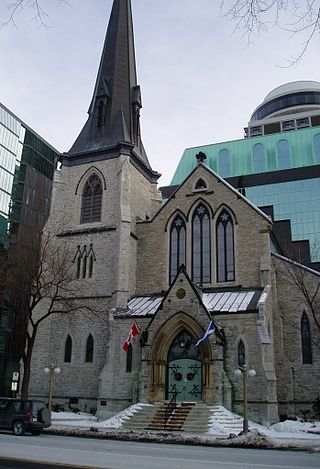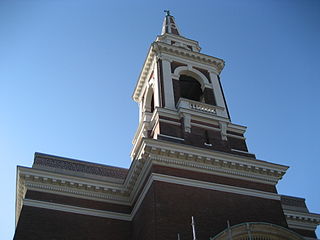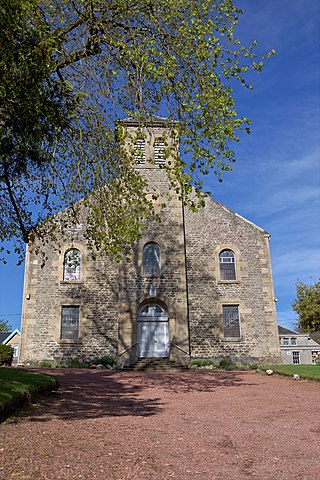
The Presbyterian Church (USA), abbreviated PC (USA), is a mainline Protestant denomination in the United States. It is the largest Presbyterian denomination in the country, known for its liberal stance on doctrine and its ordaining of women and members of the LGBT community as elders and ministers. The Presbyterian Church (USA) was established with the 1983 merger of the Presbyterian Church in the United States, whose churches were located in the Southern and border states, with the United Presbyterian Church in the United States of America, whose congregations could be found in every state.
Presbyterianpolity is a method of church governance typified by the rule of assemblies of presbyters, or elders. Each local church is governed by a body of elected elders usually called the session or consistory, though other terms, such as church board, may apply. Groups of local churches are governed by a higher assembly of elders known as the presbytery or classis; presbyteries can be grouped into a synod, and presbyteries and synods nationwide often join together in a general assembly. Responsibility for conduct of church services is reserved to an ordained minister or pastor known as a teaching elder, or a minister of the word and sacrament.

The Cumberland Presbyterian Church is a Presbyterian denomination spawned by the Second Great Awakening. In 2019, it had 65,087 members and 673 congregations, of which 51 were located outside of the United States. The word Cumberland comes from the Cumberland River valley where the church was founded.
The United Free Church of Scotland is a Scottish Presbyterian denomination formed in 1900 by the union of the United Presbyterian Church of Scotland and the majority of the 19th-century Free Church of Scotland. The majority of the United Free Church of Scotland united with the Church of Scotland in 1929.

St. Andrew's Presbyterian Church is the oldest Presbyterian church in Ottawa, Ontario, Canada.

The Presbyterian Church in Canada is a Presbyterian denomination, serving in Canada under this name since 1875. The United Church of Canada claimed the right to the name from 1925 to 1939. According to the Canada 2001 Census 409,830 Canadians identify themselves as Presbyterian, that is, 1.4 percent of the population.
Walter George Brown was a Presbyterian Church in Canada minister who opposed the formation of the United Church of Canada and was a United Reform Movement MP in the House of Commons of Canada.

St. Andrew's Church is a historic Presbyterian church located at the corner of King Street West and Simcoe Street in the city's downtown core of Toronto, Ontario, Canada. It was designed by William George Storm in the Romanesque Revival style and completed in 1876.

First Presbyterian Church is a historic Presbyterian Church in Canada congregation and Gothic Revival church building in the city's downtown core of Edmonton, Alberta, Canada. The congregation celebrated its 125th anniversary in November 2006.

Wellington Church is a congregation and parish church of the Church of Scotland, serving part of the Hillhead area of Glasgow, Scotland. The building is located on University Avenue, Glasgow, opposite the University of Glasgow.
The International Presbytery covers the Church of Scotland's congregations in continental Europe, Sri Lanka and the Caribbean. Until 2016 it was called the Presbytery of Europe. In October 2014 it was agreed to move towards changing the name to the International Presbytery.

Central Presbyterian Church is a Presbyterian Church in Canada congregation in Hamilton, Ontario, Canada, located in the downtown area at the corner of Charlton and Caroline Street South.

Presbyterian Church of East Africa (PCEA) is a Presbyterian denomination headquartered in Nairobi, Kenya. In Kenya, 10% of the population is Presbyterian. It was started by missionaries from Scotland, most notable of whom was Dr John Arthur. It has its headquarters in Nairobi South C.
Attitudes in Presbyterianism toward homosexuality vary, ranging from outright condemnation to complete acceptance. The World Communion of Reformed Churches has not taken a position on the issue of homosexuality.
Warrenton Presbyterian Church is a Presbyterian congregation in Warrenton, Virginia that was organized around 1780.

Abbeygreen Church is a congregation of the Free Church of Scotland in the small town of Lesmahagow, Lanarkshire. As a Christian congregation, it is presbyterian and reformed; holding the Word of God, the Holy Bible, as the supreme rule of life and doctrine and the Westminster Confession of Faith as a sub-ordinate standard, which helps explain the doctrines of the Christian faith. Being Presbyterian, it serves as part of the Free Church of Scotland Presbytery of Glasgow and seeks to faithfully serve God in Lesmahagow and the surrounding area. Having a missional outlook it is involved with a number of missionary organizations including, but not only, UFM Worldwide and Rose of Sharon Ministries, and helps with the organization and support of the Scottish Reformed Conference.
The Presbytery of Glasgow is one of the 46 Presbyteries of the Church of Scotland. It dates back to the earliest periods of Presbyterian church government in the Church of Scotland in the late 16th century. The Presbytery of Glasgow currently has 125 congregations, making it by far the largest Presbytery in the Church of Scotland.

Baillieston St Andrew's Church is a congregation of the Church of Scotland, a member of the Presbyterian Church. The church building is located on the corner of Bredisholm Road and Muirhead Road, Baillieston, Glasgow, Scotland. The church today serves the town of Baillieston.

The Unitarian Church in Ireland presently consists of two Congregations, Dublin and Cork, part of the Synod of Munster, in the Republic of Ireland, which has itself been part the Non-Subscribing Presbyterian Church of Ireland since 1935. Some congregations remain closely associated with the General Assembly of Unitarian and Free Christian Churches. These churches would abide by the traditional Unitarian principles of Freedom, Reason and Tolerance.

Westminster Presbyterian Church is in the Jefferson Park neighborhood of Los Angeles, California. Westminster Presbyterian Church is a member of the Presbyterian Church (U.S.A.), the Synod of Southern California and Hawaii and Pacific Presbytery. The congregation, established in 1904, is one of the oldest African American Presbyterian churches in California and west of the Mississippi River.














